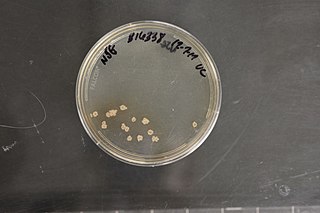The Aurantimonadaceae are a small family of marine bacteria.

The Hyphomicrobiaceae are a family of bacteria. Among others, they include Rhodomicrobium, a genus of purple bacteria.

Treponema is a genus of spiral-shaped bacteria. The major treponeme species of human pathogens is Treponema pallidum, whose subspecies are responsible for diseases such as syphilis, bejel, and yaws. Treponema carateum is the cause of pinta. Treponema paraluiscuniculi is associated with syphilis in rabbits. Treponema succinifaciens has been found in the gut microbiome of traditional rural human populations.

The Actinomycetia are a class of bacteria.
Rubrobacter is a genus of Actinomycetota. It is radiotolerant and may rival Deinococcus radiodurans in this regard.

Bacteroidales is an order of bacteria. Notably it includes the genera Prevotella and Bacteroides, which are commonly found in the human gut microbiota.

The order Flavobacteriales comprises several families of environmental bacteria.

The Glycomycetaceae are a family of bacteria.
The Selenomonadales are an order of bacteria within the class Negativicutes; unlike most other members of Bacillota, they are Gram-negative. The phylogeny of this order was initially determined by 16S rRNA comparisons. More recently, molecular markers in the form of conserved signature indels (CSIs) have been found specific for all Selenomonadales species. On the basis of these markers, the Selenomonadales are inclusive of two distinct families, and are no longer the sole order within the Negativicutes. Several CSIs have also been found specific for both families, Sporomusaceae and Selenomonadceae. Samples of bacterial strains within this order have been isolated from the root canals of healthy human teeth.
Pedobacter africanus is a species of heparinase-producing bacteria.
Phyllobacterium is a genus of Gram-negative, oxidase- and catalase-positive, aerobic bacteria.
Pedobacter heparinus is non-spore-forming, Gram-negative bacterium that can use carbohydrates as its sole nutrient source.
Erythrobacteraceae is a bacterium family in the order of Sphingomonadales.
Pseudopedobacter saltans is a species of heparinase-producing bacteria. Pedobacter saltans was reclassified to Pseudopedobacter saltans.
Kaistiaceae is a family of Alphaproteobacteria.
Pleomorphomonadaceae is a family of Alphaproteobacteria.
The Streptosporangiales are an order of bacteria.
The Propionibacteriales are an order of bacteria.
Balneolales is an order of bacteria.
The Holophagae is a class of Acidobacteriota.





